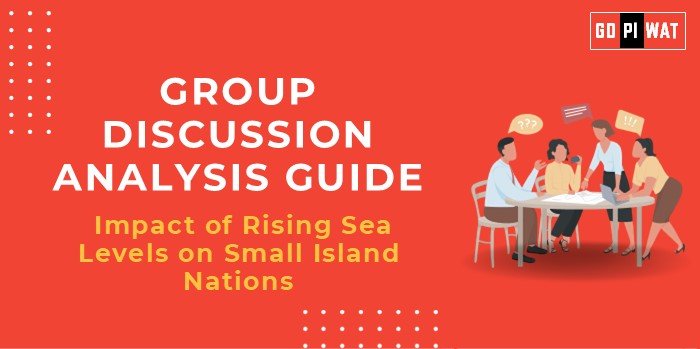📋 Group Discussion (GD) Analysis Guide: Impact of Rising Sea Levels on Small Island Nations
🌊 Introduction
Rising sea levels, driven by accelerating climate change, pose a dire threat to the survival and prosperity of Small Island Developing States (SIDS). Despite contributing minimally to global greenhouse gas emissions, these nations face severe environmental, economic, and social consequences.
📊 Quick Facts & Key Statistics
- 📈 Sea Level Rise Rate: Global mean sea level rose by 3.6 mm/year from 2006-2015, marking an accelerated increase compared to previous decades (IPCC).
- 👥 Vulnerable Population: SIDS are home to 65 million people, disproportionately vulnerable to sea-level rise, despite representing less than 1% of the global population (UN).
- 💸 Economic Cost: Annual economic losses for SIDS could reach USD 75 billion by 2050 due to climate-induced extreme weather (World Bank).
- 🌍 CO₂ Levels: SIDS contribute less than 1% to global emissions but are among the most affected, highlighting an acute disparity (UNFCC).
🤝 Stakeholders and Their Roles
- 🏛️ National Governments: Enact policies for coastal protection and advocate for international aid.
- 🌐 Global Organizations: Provide financial aid and technical expertise (e.g., UNDP, Green Climate Fund).
- 💼 Developed Nations: Support emission reduction initiatives and provide equitable climate financing.
- 🔬 Private Sector: Invest in innovative technologies for resilience, such as seawalls and renewable energy.
- 🏘️ Local Communities: Strengthen grassroots resilience through education and sustainable practices.
🏆 Achievements and Challenges
✔️ Achievements
- 🌍 International Agreements: Paris Agreement and Green Climate Fund establishment for SIDS support.
- 🚧 Innovation: Floating city projects in the Maldives and Fiji’s climate-resilient infrastructure projects.
- 📣 Awareness Campaigns: Successful advocacy at UN Climate Summits.
⚠️ Challenges
- 🏠 Displacement and Migration: Rising seas force communities to relocate, disrupting cultures and economies.
- 🛠️ Infrastructure Vulnerability: Limited resources hinder the ability to build protective measures.
- ⚖️ Global Climate Inequity: Significant disparity between emissions contributions and impacts faced by SIDS.
💡 Effective Discussion Approaches
- 📊 Opening Approaches:
- “SIDS could face USD 75 billion in annual economic losses by 2050 due to sea-level rise…”
- “Despite contributing less than 1% to global emissions, SIDS endure the harshest impacts of climate change…”
- 💬 Counter-Argument Handling:
- Acknowledge slow international response but highlight potential solutions, such as leveraging Green Climate Fund allocations effectively.
🛠️ Strategic Analysis of Strengths & Weaknesses
- Strengths: Strong advocacy at global climate platforms, innovative resilience solutions like floating cities.
- Weaknesses: Limited funding and technology access.
- Opportunities: Increased focus on global equity and new climate adaptation technologies.
- Threats: Intensifying climate events and geopolitical neglect.
🔑 Structured Arguments for Discussion
- ✅ Supporting Stance: “Global funding initiatives have enabled vital climate resilience projects in SIDS.”
- ❌ Opposing Stance: “International commitments remain inadequate, given the accelerating pace of climate impacts.”
- ⚖️ Balanced Perspective: “While international efforts are progressing, far greater cooperation is necessary to ensure SIDS’ survival.”
📚 Connecting with B-School Applications
- 💼 Real-World Applications: Explore how global finance impacts climate adaptation.
- ❓ Sample Interview Questions:
- “How can international aid be optimized for small island nations facing climate challenges?”
- “What role does private investment play in creating resilient infrastructure?”
- ✨ Insights for Students: Consider sustainable investment strategies and their role in reducing climate vulnerabilities.


